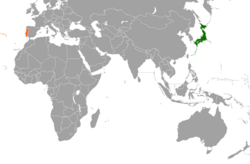Japan–Portugal relations
 |
|
|
Japan |
Portugal |
|---|---|
Japanese–Portugal relations describes the foreign relations between Japan and Portugal. Although Portuguese sailors visited Japan first in 1543, diplomatic relations started in the nineteenth century.
The first affiliation between Portugal and Japan started in 1543, when the Portuguese discoveries, the first Europeans to reach Japan, landed in the southern archipelago of Japan. This period of time is often entitled Nanban trade, where both Europeans and Asians would engage in mercantilism. The Portuguese at this time would found the port of Nagasaki, through the initiative of the Jesuit Gaspar Vilela and the Daimyo lord Ōmura Sumitada, in 1571.
The expansion for commerce extended Portuguese influence in Japan, particularly in Kyushu, where the port became a strategic hot spot after the Portuguese assistance to Daimyo Sumitada on repelling an attack on the harbor by the Ryūzōji clan in 1578.
The cargo of the first Portuguese ships upon docking in Japan were basically cargo coming from China (silk, porcelain, etc.). The Japanese craved these goods, which were prohibited from the contacts with the Chinese by the Emperor as punishment for the attacks of the Wokou piracy. Thus, the Portuguese acted as intermediaries in Asian trade.
In 1592 the Portuguese trade with Japan started being increasingly challenged by Chinese smugglers on their reeds, in addition to Spanish vessels coming to Manila in 1600, the Dutch in 1609, and English in 1613.
One of the many things that the Japanese were interested in were Portuguese fire guns. The first three Europeans to arrive in Japan in 1543 were Portuguese traders António Mota, Francisco Zeimoto and António Peixoto (also presumably Fernão Mendes Pinto). They arrived at the southern tip of Tanegashima, where they would introduce firearms to the local population. These muskets would later receive the name after its location.
...
Wikipedia
